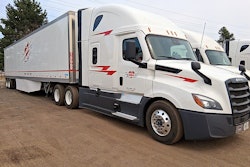Although the House and Senate each are on record as wanting to zero out funding for the Bush administration’s Mexican carrier pilot program, it appears the demonstration project will continue for at least a few weeks more.
Also, the Federal Motor Carrier Safety Administration announced Thursday, Sept. 27, that all Mexican and U.S. vehicles participating in the ongoing cross-border project will have to participate in a satellite-based vehicle tracking system under a plan being developed by FMCSA and the government of Mexico’s Secretaria de Communicaciones y Transportes.
The next fiscal year begins Oct. 1, and the House and Senate have yet to pass a consensus version of the Department of Transportation appropriations bill. Instead, Congress apparently will pass a so-called continuing resolution that will provide funding while lawmakers resolve differences on the various appropriations bills.
On Wednesday, Sept. 26, the House passed its version of the continuing resolution (H.J. Res. 52), which continues federal funding through Nov. 16. Although there are some special provisions attached, a funding prohibition on the pilot program is not one of them. However, the final version of the DOT appropriations bill still could kill the program at a later date.
Meanwhile, FMCSA intends to issue a contract to provide satellite terminals for the near real-time tracking of trucks traveling throughout the United States and Mexico as part of the cross-border project. In May, the two countries agreed to explore satellite technology as an enforcement tool for the project.
The systems will be installed at no cost to the participating trucking companies – it is not required on U.S. trucking companies operating solely within the United States, said John Hill, FMCSA administrator. “This will give us the ability to monitor every vehicle from Mexico and ensure all companies are following our strict safety requirements, including those governing hours of service and cabotage,” Hill said.
The vehicle tracking system will incorporate a global positioning system and wireless technology to accurately determine a vehicle’s position, and will be used to monitor hours of service, cabotage violations (the point-to-point shipping of domestic loads within the United States) and date and time of international and state crossings, FMCSA said. Vehicles will be tracked by vehicle number and company – no driver information will be collected or tracked, according to the agency.
Earlier this week, Tijuana-based Transportes Padilla became the third Mexican trucking company to receive authority to make long-haul deliveries in the United States as part of the cross-border program; the company intends to operate three vehicles. A list of U.S. and Mexico trucking companies that have received authority to participate in the project is available here.
“We are enforcing tough safety standards at every stage of this demonstration as we tap into this unique opportunity to compete in new markets and increase border trade efficiency,” Hill said. “There is tremendous potential to reduce costs for American consumers and businesses while maintaining safety on American roads.”
While critics of the program — including the Owner-Operator Independent Drivers Association, the Teamsters union and a number of members of Congress — have raised safety concerns about Mexican trucks, FMCSA argues that thousands of Mexican trucks already operate every day in U.S. cities such as San Diego and El Paso, Texas. In 2006 alone, Mexican trucks crossed into the United States 4 million times, while no U.S. trucks were allowed to enter Mexico.
For years, however, those Mexican trucks have been limited to the 25-mile border commercial zone within the United States. The program launched Sept. 6 allows long-haul operations for up to 100 Mexican carriers throughout the United States, and up to 100 U.S. carriers throughout Mexico.
OOIDA on Friday, Sept. 28, expressed skepticism in response to FMCSA’s satellite tracking system. “It may sound impressive to those unfamiliar with the industry or the limits of the technology, but closer scrutiny verifies it’s a cosmetic cover-up for a poorly conceived program,” said OOIDA Executive Vice President Todd Spencer. “You can polish up a rock, but then you’ll just have a shiny rock.”
Spencer doubted FMCSA’s claims that the system will monitor whether drivers are complying with driving time limits, saying the agency cannot even currently do this with U.S. drivers, not without checking paperwork or other manual records. “I don’t see how this ensures anything from a safety or security standpoint,” he said. “We’d like FMCSA to explain in more detail exactly how this system will actually keep track of the hours of service of a trucker.”
Spencer pointed out that FMCSA stated that no driver information will be collected or tracked. “And as we might have expected, FMCSA has U.S. taxpayers picking up the tab for this from money that should be spent on highways and bridges,” he said.








